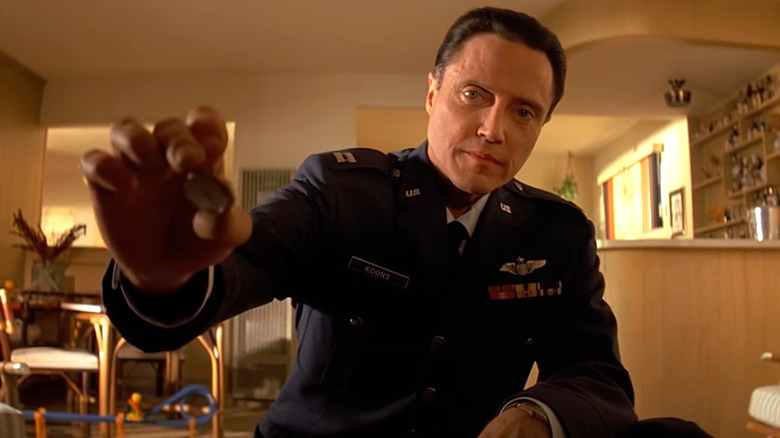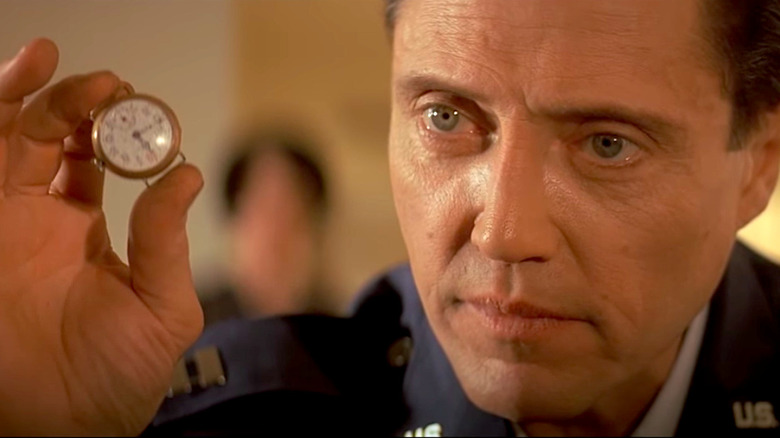How Quentin Tarantino Cobbled Together Christopher Walken's Famous Pulp Fiction Scene
There are many memorable moments in Quentin Tarantino's "Pulp Fiction." Royales with cheese. Jules' majestic watch. Jack Rabbit Slim's. Poor, poor Marvin. But one moment that often stands out above all the rest is The Watch Scene. You know the one, where a serious-faced Captain Koons (Christopher Walken) delivers the most impeccable speech to a young Butch Coolidge about the watch that has been passed down by the Coolidge men from generation to generation as a family heirloom that has seen and survived three of America's greatest wars.
At first, it seems like a touching story. "The way your dad looked at it, this watch was your birthright," Captain Koons tells Coolidge, but as he tenderly fondles the timepiece with his fingers, he reveals that the only way Coolidge's father could ensure the watch would make it back to his young son was to hide the watch up his ass for five straight years while he was kept in a POW camp alongside Captain Koons. When Coolidge finally and ironically succumbed to a bad case of dysentery, it was Koons who made the decision to take responsibility for the watch, hiding it up his ass for another two years before he was rescued. Suddenly, you're wondering if that thing has ever been properly cleaned.
The brilliance of the scene lies in Walken's impeccable comedic ability, but it also gets its power from the deliberate choices Tarantino made while filming various takes. It turns out that watches being hidden up the booty are funny, but only if the build-up to the punchline is properly executed.
The vocabulary of perspective
When you see the watch scene for the first time, at first there is a somberness to it. Captain Koons is a sincere man, here to deliver this precious gift to its rightful heir, ensuring that this piece of the Coolidge family history continues its journey. Sentimentality is strong here, but the scene also resonates with the kind of apathy reserved only for children when they are faced with an adult who is trying to impart their wisdom. This indifference is made real through Tarantino's choice to angle the majority of the shots up at Walken's face, giving the audience the same viewpoint of young Butch peering up at this strange man who he's never met before. It's an effective choice that allows the scene to both linger in its emotion while also leaving room for the humor that we don't yet know is coming.
In an interview for Film Comment, Tarantino talks about how this scene was shot, highlighting his decision to focus on point of view. He says, "I shot maybe 13 or 14 takes of the basic shot that you see in the movie, the kid's point of view. Then I did five or six takes of [Walken] doing it in closeup, and then I just had the little kid."
Throughout each of these takes, Tarantino had Walken deliver the monologue in varying levels of intensity, eventually choosing to use certain takes for specific parts of the story based on the level of sincerity he was going for.
"I could use the more humorous take on the First World War and then the Second World War story where [Walken's] talking about Wake Island, which is more tragic, I took his darkest take, and then for the Vietnam story I took his most irreverent one, which is the funniest."
The result is the iconic scene that has been cemented in cinematic history forever.
"One of the fun things about making a movie is, there's a whole lot of vocabulary so this scene I'll shoot in one long take, this scene I want to do through forced perspectives, this scene I want to do with very minimal coverage, like the bathroom scene between Bruce Willis and Maria de Medeiros," says Tarantino. And he's absolutely right. This famous scene is effective because Tarantino chose to subtlety fluctuate the tone — or vocabulary — of the scene so that when the ass-tronomical reveal finally occurs, it's that much more, shall I say, explosive.

